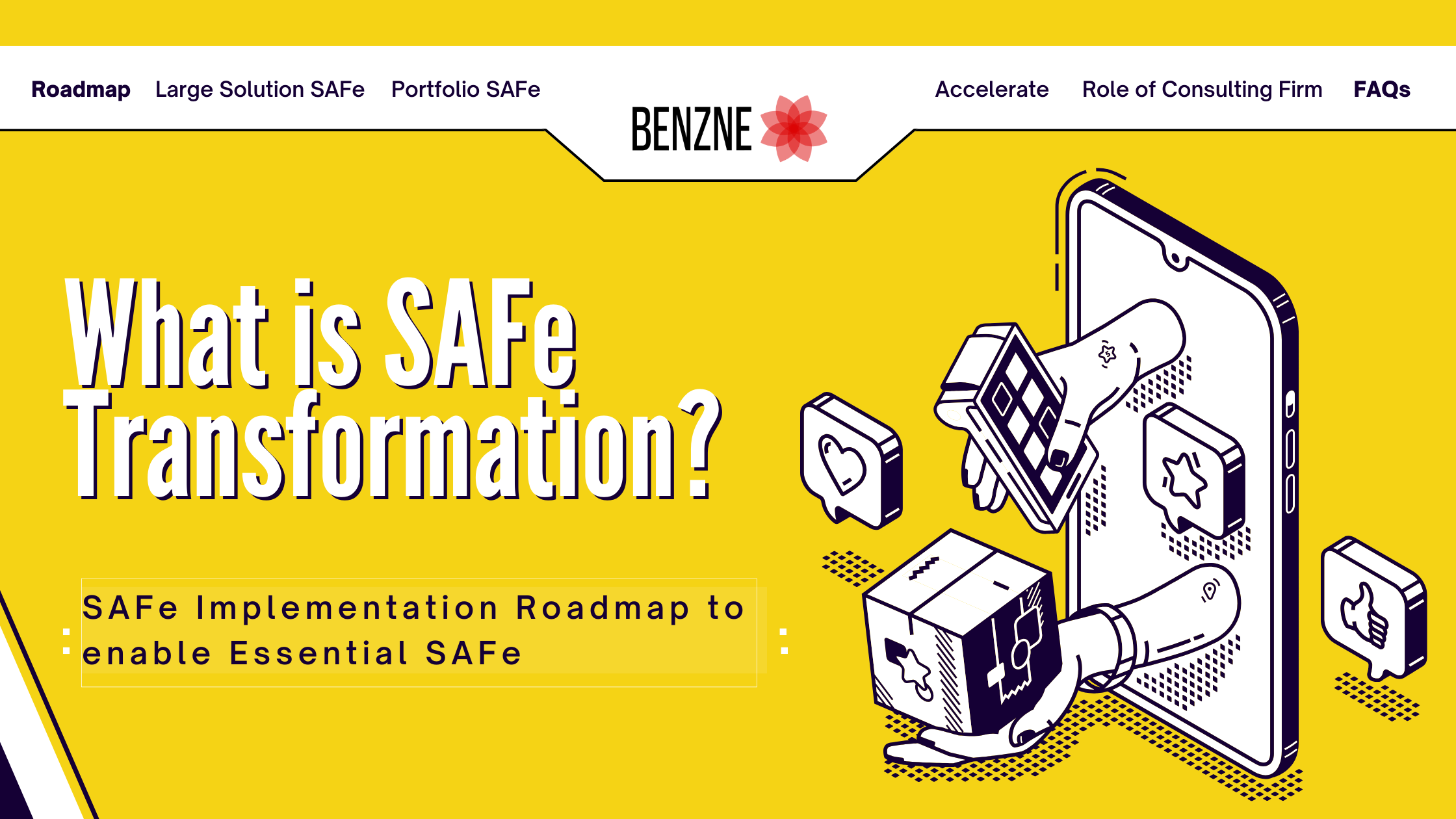SAFe stands for ‘Scaled Agile Framework’ and stands tall as one of the popular and widely applied approaches for organizations who want to drive SAFe transformation, bringing agility at all levels.i.e
- Business agility at the level of organization
- Portfolio level
- Program level
- Teams
- and beyond
Many such approaches are prevalent in the market like the Spotify model, Nexus, LeSS, LeSS Huge, Scrum at Scale, DAD, etc. but what distinct SAFe from its counterparts are a few differentiators:
- Extensive literature
- Focused courses on role and skill-based competencies
- Flexibility to model it based on your need
- Essential SAFe
- Large Solution SAFe
- Portfolio SAFe
- Full SAFe
- Certifications
- Evolving by continuously updating the framework with runtime talk-of-the-town aspects like AI, Big Data, etc in its versions
While SAFe Transformation has its benefits, one must also consider certain nuances like the ones below while exploring the best fit ‘scaling model’ for their context:
- It might look overwhelming unless you spend good time understanding its context and relate it to your need
- Since its a scaling framework henceforth it requires onboarding various stakeholders as per its Implementation roadmap
- Too much to remember and demands specialists to implement and maintain its sanctity
SAFe Implementation Roadmap to enable Essential SAFe
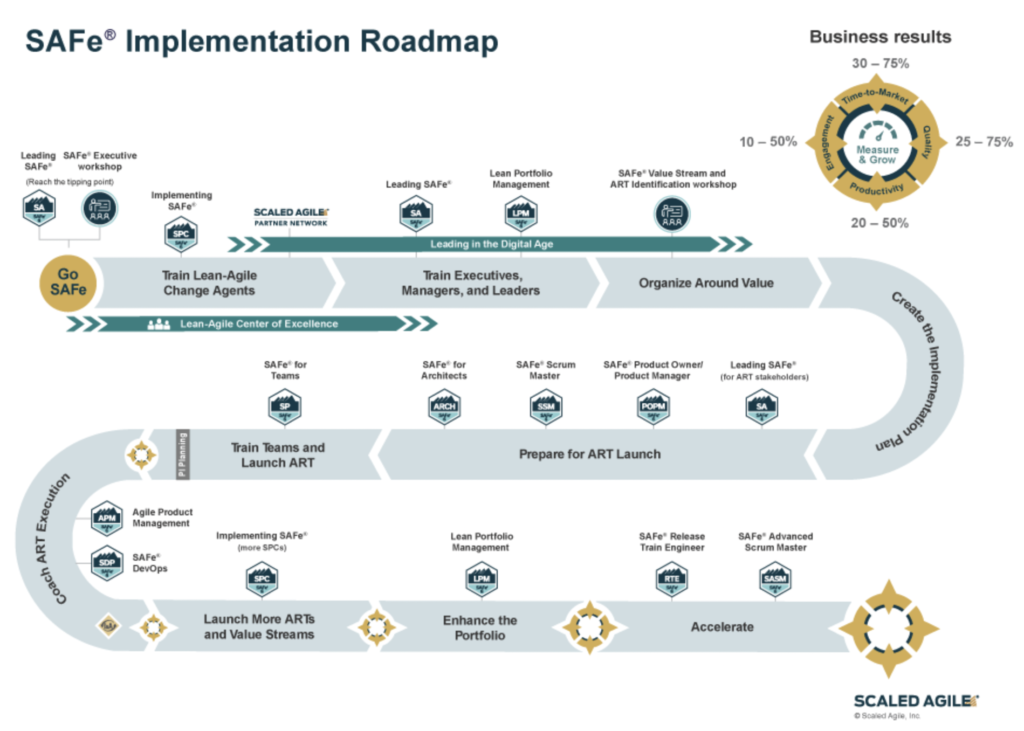
It is a step-by-step guideline to implement the framework. This is how we interpret this roadmap:
- To get started, it is important to identify the need, the aspirations of the firm, and most importantly the onboarding of the leadership team.
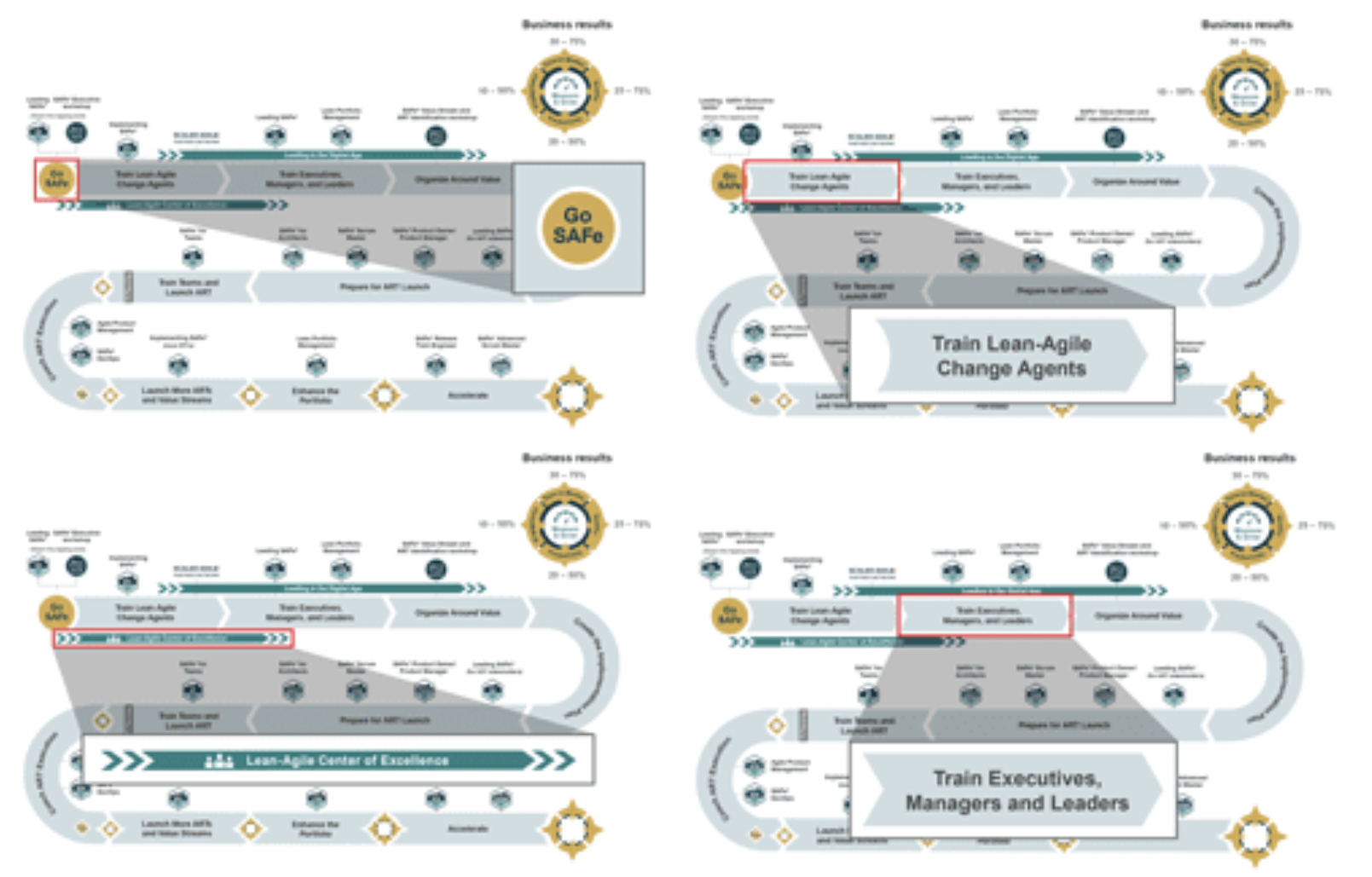
To do so SAFe suggests kickstarting the SAFe-led transformation journey by following steps:
- Train the executives to onboard them using the SAFe Executive workshop
- Conduct Leading SAFe workshop to let them understand the journey ahead and the possible changes that will happen
- Identify SAFe champions by making them SAFe Practice Consultants (SPC) through Implementing SAFe workshop, they are also referred to as Lean-Agile Change Agents
- Further on, train the early adopters who will be identified as the participants of the first ART (Agile Release Train) launch like executives, managers, leaders & others through Leading Agile workshops and Lean Portfolio Management to those who will be involved at the Portfolio layer and responsible for funding the Development Value Stream
- Also, setting up Lean-Agile Center of Excellence (LACE), they will be responsible for ensuring the aesthetics of the implementation is aligned with the SAFe transformation roadmap
- Next step is to let organization leaders learn how to organize around the value.
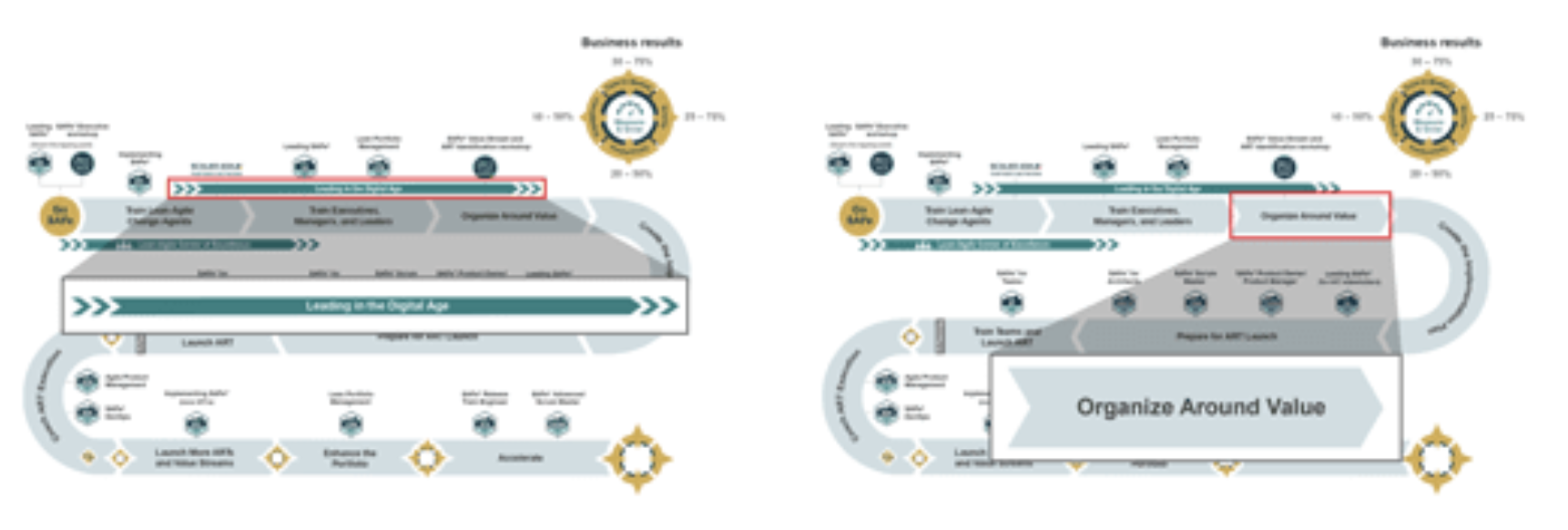
This happens by,
- Conducting the Lean Portfolio Management (LPM) workshop
- Identifying the Operational value stream and development value stream
- Mobilizing the workforce around the Development Value Stream (DVS)
- Helping those executives understand the essence of Business Agility, the purpose of defining Strategic themes using the OKR technique, the essence of Epic Owners and their outcomes, the concept of MVP, lean budgeting, and events (Strategic Portfolio Review, Portfolio Sync, Participatory budgeting), and value of identifying KPIs that the value streams are going to deliver
- Now is the time to create the implementation plan

- Implementation plan itself says that it’s time to get started as we already been through setting the aesthetics in place
- This implies, picking the first value stream and the first ART in that value stream to start with
- Then, starting with preliminary preparations which few may call it as pre-PI planning which includes:
- Setting up the vision to communicate
- Product strategy for the first Planning Interval and may be for upcoming too
- Architectural runway readiness
- Identifying key roles for Solution Train like Solution Architect, Solution Train Engineer (STE) and Solution Management team
- Identifying the key roles for the ART like Product Management, Release Train Engineer (RTE) and System Architect
- The SAFe Practice Consultant (SPC) ensures that all the above and anything beyond that necessary for the successful kickstart are in place
- Prepare for the ART launch includes the following guidance by Scaled Agile Framework:
- Define the ART
- Set the ART launch date and cadence calendar
- Train ART leaders and stakeholders
- Form Agile teams
- Train Product Managers and Product Owners
- Train Scrum Masters/Team Coaches
- Train System Architects
- Assess and evolve launch readiness
- Prepare the ART backlog
- And the other additions could be,
- Identifying the PI goals for the ARTs
- Identifying and populating the tools for collaboration
- Ensuring EPICs are in place and the respective features and enablers have been identified
- The timetable for the PI has been drawn and the events are published
- The aspects like distributed teams, remote ways of working, video/audio instruments and applications are taken care
The preparations demand many other aspects like setting up the system team, shared services team, setting up the development infrastructure and onboarding other teams like security, infosec etc who will play a crucial role in the success of the ART that we have formed.
- Next comes, training teams and launching the ART. SAFe has the following suggestions:
- Day one and two, conduct SAFe for Teams to onboard them with Scaled Agile Transformation approach and what will happen during the PI planning and execution
- Day three and four is about doing the PI planning. Here, there is a complete itinerary starting from open house by executives presenting the vision till it all ends at PI retrospective at the offset of 2 days event
- Day five is about populating the data on the project management tool, training the key roles on PI execution norms and also certain tool training for teams
- The experience of the first ART and its first PI is unique. As the future PIs commence, the agenda of this week gets tweaked since the ART teams have already gained the experience and they are accommodated with the new ways of working. Then the focus is more on continuous refinement to make it more purposeful to generate impact.
- Coaching ART execution is a very critical part. As it is important for people to understand the benefits of scaled agile transformation (here SAFe).

There are various aspects to be taken care of when it comes to ART execution like:- Iteration Planning
- Team Sync
- Backlog Refinement
- Iteration Reviews
- System Demos
- Coach Sync
- PO Sync
- ART Sync
- Team assessments
While these events are important and have their own significance, at the same time views like Program Kanban board and team-level Kanban board helps the team in understanding the flow metrics.
Also, the PI has the last iteration identified as IP Iteration which is meant for ‘Innovation & Planning’ where the first week is about innovation activities and the second week emphasis on Inspect and Adapt events and planning for the next PI.
The goal of execution is not just to be stuck to the plan that we have had during the PI planning but also to be agile with adjusting the unplanning changes and being successful. So far we have covered the step by step of SAFe transformation for an organization as guided by Scaled Agile Transformation. It was so far about Essential SAFe implementation and now let’s explore the other versions of SAFe. Most of the agile consulting on SAFe happened at this level but the organizations who are aspiring for the business agility go-beyond like portfolio, large-solution and finally to full SAFe. It all depends case by case.
Boost your business success with expert OKR Consulting services. Align, focus, and achieve your goals. Contact us for tailored OKR solutions to drive results.
Large Solution SAFe
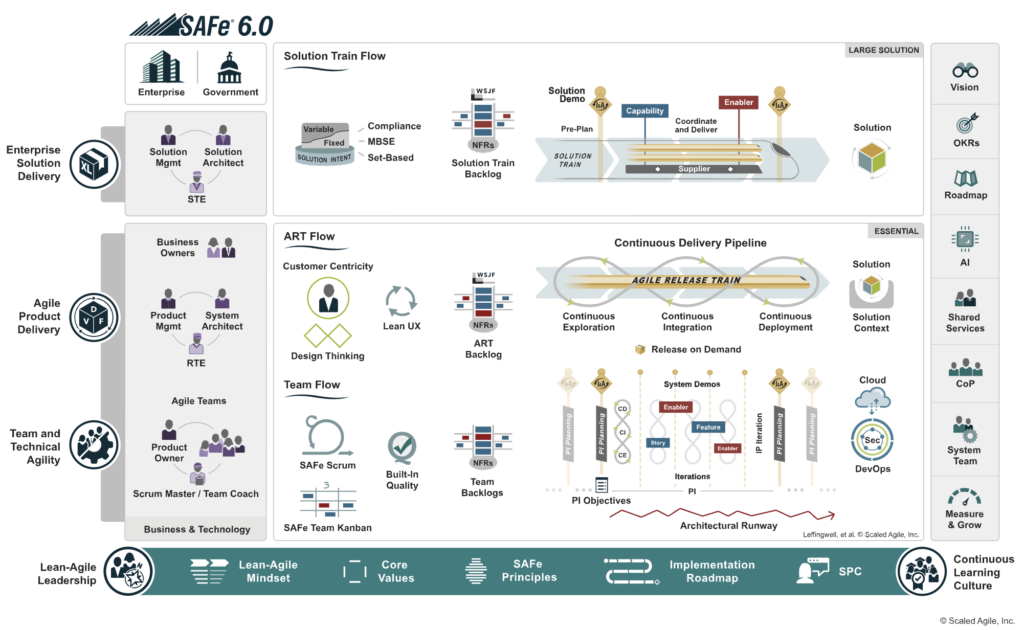
It is primarily used when the solutions as its name suggests are larger in size and cost of failure is unacceptable. It includes alignment of multiple ARTs to the solution vision.
As suggested by SAFe, “few examples of circumstances where the enterprise solution delivery configuration applies include:
- Large consumer solutions that host complex user journeys and experiences across multiple products and lines of business
- Cyber-physical systems that require a broad range of engineering disciplines and utilize hardware and other long lead-time items
- High assurance systems of any scope that are subject to significant safety and compliance requirements
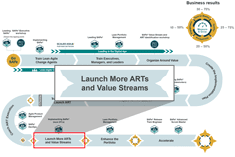
This is the point, when within the same value stream, we should focus on launching more ARTs and create provision for seamless orchestration at such scale. A few more suggestions from SAFe, - Set roles for Large Scale Solutions:
- Identify & train the following large solution roles—Solution Train Engineer (STE), Solution Management, and Solution Architects, creating leadership and alignment across ARTs and critical stakeholders.
- Assure Solution Intent:
- Ensure the responsibilities, process, and tools to define and maintain Solution Intent, considering creating the right level of variability.
- Derive a large solution Vision, Roadmap, and Metrics:
- Many elements of the spanning palette may be required for large value streams. These include vision, roadmap, metrics, Shared Services, System Team, DevOps strategies, Lean User Experience (UX), AI-enabled solutions, and OKRs.
- Identify the Solution Train Backlog:
- Larger value streams benefit from using the capabilities backlog item, in which case the Solution Train Kanban must also be established.
- Setting up & facilitating the large solution events:
- These events are required to prepare for individual ART PI planning, coordinate Solution Train PI Objective delivery and dependencies, align on the combined architectural runway, and demonstrate the whole solution to stakeholders. Activities that create cross-ART alignment opportunities include Solution Demos, Pre-plan activities, large solution Inspect & Adapt, and Architect Syncs.
- Integrate suppliers:
- Large value streams typically have internal and external strategic Suppliers. Whether they embrace and practice SAFe principles and a Lean-Agile mindset, they must coordinate to deliver the solution’s potential. Whatever the case, the suppliers must at least integrate into SAFe events at the large solution level.
While we are adding more ARTs to a value stream, it is also important to launch more development value streams (DVS) that are aligned to the Operational value stream (OVS). While there is one OVS for a portfolio and a portfolio can have multiple DVS.
Portfolio SAFe
A recap. We started with training leaders, setting up LACE, training more on SAFe, identifying value streams to organize around value, preparing for the SAFe implementation, then launching the ART, executing it and then further launching more ARTs and value streams.
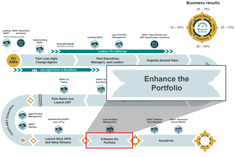
Now is the time to enhance the portfolio. Enhancing the portfolio means,
- Adopting Lean Portfolio Management (LPM)
- Reorganizing value
Setting up the LPM means the following:
- Publishing the strategic themes with OKRs
- Portfolios aligning to the strategic themes
- Epic owners focusing on identifying KPIs to fulfill OKRs
- Lean budgeting to evaluate and sponsor MVPs
- Events like Portfolio Sync, and Strategic Portfolio Review in action to review the progress made
- Participatory budgeting to decide on decommissioning sponsorship of EPICs that have reached its maturity state and do not need further investments, persevere those who have met their benefit hypothesis and pivot to experiment and learn deeply
- Focusing on solution context for respective value streams
- Evaluating the fulfillment of features and enablers who are supposedly achieving the KPIs
- Bring balance between Epics and Enablers as enablers are equally important for upbeat architecture, platform and aspects like scalability, performance, security, compliance and other aspects
- Continuously validating the value generating solutions and repurposing them when required.
With LPM functioning harmoniously, the portfolio is not self-sustaining. Now is the time to ensure that the value flows without interruptions.
Accelerate
Once we have set the structural aspects, wherever needed with continuous focus on making the agile SAFe transformation purposeful and sustaining, now is the time to focus fully on letting the value flow at all levels without any interruptions. While, it has been the focus since beginning but now is the time to make it an overall purpose holistically.
Flow metrics will help in identifying the areas of improvements:
- Flow Distribution – it helps in identifying the issue-types within the backlog i.e. Features Vs Enablers. If we emphasis too much on features then there is a possibility of poor solution health and might be legacy codebase which may further affect the performance.
- Flow Velocity – helps in determining the amount of work completed within a specific time. This way we could predict the future load an ART can take and understand the expected due dates
- Flow Time – is about the time taken for a work to get finished. This may help us in visualizing the waste time and also look at the priorities
- Flow Load – is the amount of work in process. If you have most of the work in process within any PI then that means that you are running it in a waterfall way not agile. This should be limited so as to ensure that we are pulling the right amount of work, sizing them just-enough and continuously delivering it
- Flow efficiency – out of the total time a work has taken to finish, how much was actually the active time? It will help in identifying all the reasons which caused the work to stop and there could be reasons like handover time, approvals, outdated technology, unavailability of resources etc
- Flow predictability – it is about the actual business value delivered against the plan. The planning happened during the PI planning event and we continuously observe the delivered value throughout the PI and then at the end of the PI, we compare and plot it. Across the PIs we observe the trend which may help us into identifying the patterns which might be letting us know about upcoming PIs and possibly pivot or persevere our decisions.
The above accelerators must be applied at all levels and continuously improving the Kanban system will keep us knowing the opportunities of improvement. Push innovations to customers so that they can pull value from us. People need to be continuously trained, especially the key roles and we should encourage innovation, to promote a continuous learning culture.
Recommended Read
Role of consulting firms in SAFe Transformation
Driving transformation at scale needs internal champions and also the external ones who will bring their expertise of successful scaled agile transformation, in this case specific to Agile SAFe transformation. Following could be benefits of getting external consulting firms to support your SAFe Transformation-
- Onboarding the various stakeholders with case studies, deeper analysis and quick wins on low-hanging problems
- Partnering with internal teams to drive changes and creating center of excellence or cohorts (like LACE) to enable them to drive forward
- Outside-in perspectives to think and act differently
- Expertise to maneuver based on right-fit
- Credibility and authenticity
- Independent and unbiased views
- Assess and facilitate in identifying and resolving the critical paths
- Training and mentoring internal competencies
At Benzne, we are the team of practitioners who understands organizational dynamics and have led SAFe based scaling agile transformations across multiple clients. Reach out to us at consult@benzne.com to discuss more about how you should plan your SAFe Agile Transformation journey for a successful Agile Transformation SAFe.
SAFe is a registered trademark of Scaled Agile Framework.
FAQ Questions
What is the difference between SAFe and Scrum?
Scrum and SAFe both are frameworks & the key difference is, that Scrum focuses primarily on a small team of size 7-10 members while SAFe is a scaled agile framework which could be applied at organizations of any size.
What is the main goal of a SAFe transformation?
Main goal of Agile Transformation SAFe is to help enterprises thrive in the digital age by delivering innovative products and services faster, more predictably, and with higher quality.
What are the configurations of SAFe?
a. Essential SAFe
b. Large Solution SAFe
c. Portfolio SAFe
d. Full SAFe
What are the benefits of SAFe methodology?
a. Improves business outcomes
b. Evolves continuously
c. Balance between business and technology
d. Strong focus on value and people are organized around it
e. As it’s a framework, it can be modeled and applied according to your need

